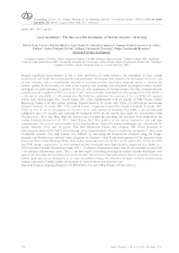Goat incubator: the doe as a life incubator of bovine oocytes - first step.
Goat incubator: the doe as a life incubator of bovine oocytes - first step.
Author(s): BATISTA, R. I. T. P.; CAMARGO, L. S. de A.; SOUZA FABJAN, J. M. G.; PRATES, J. F.; TREVIZAN, J. T.; BRANDÃO, F. Z.; FONSECA, J. F. da
Summary: Despite significant improvements in the in vitro production of cattle embryos, the suboptimal in vitro culture environment still limits the embryo quality and production. Techniques that associate the advantages of in vivo and in vitro systems, such as intrafollicular transfer of immature oocytes, have been proposed mainly to increase the embryo quality. In this context, we tried to use a goat as live incubator and associated nonsurgical embryo transfer techniques in small ruminants to perform ex situ (in vivo) maturation of bovine oocytes. For this, immature bovine cumulus-oocyte complexes (COCs) of grade 1 and 2 were randomly distributed into two groups for in vitro (IVM; n = 38) and ex situ (ESM; n = 40) maturation. The IVM was performed for a period of 24 h in TCM-199 medium (Gibco Life Technologies, Inc., Grand Island, NY, USA) supplemented with 20 mg/mL of FSH (Pluset, Calier, Barcelona, Spain), 0.36 mM sodium pyruvate (Sigma Chemical, St. Louis, MO, USA), 10 mM sodium bicarbonate (Sigma Chemical, St. Louis, MO, USA) and 50 mg/mL streptomycin/penicillin (Sigma Chemical, St. Louis, MO, USA) at 38.8 ºC in an atmosphere of 5% CO2 in air with maximum humidity. For ESM, a pre-synchronized nulliparous goat (12 months old) received 40 immature COCs in the uterine horn apice by transcervical route (Fonseca et al., 2014 Arq. Bras. Med.vet. Zootec) and 24 h after the procedure the structures were retrieved by the uterine flushing (Fonseca et al., 2013 Small Rumin Res). For analysis of the nuclear maturation rate and lipid quantification, the oocytes were denuded (0.1% hyaluronidase), fixed (4% paraformaldehyde) and stained with 10 ?g/mL Hoechst 33342 and 10 ?g/mL Nile Red (Molecular Probes, Inc., Eugene, OR, USA) dissolved in physiological saline (0.9% NaCl) with 1mg/mL polyvinylpyrrolidone. Oocytes displaying metaphase II plate were considered matured. The lipid amount was inferred by measuring the fluorescence intensity using the ImageJ program and fluorescence intensity were compared by Student's t-test. Forty-seven percent of the structures were recovered after uterine flushing (19/40). The nuclear maturation rate was 94.5% (18/19) and 81.6% (31/38) for ESM and IVM groups, respectively. In vitro-matured oocytes contained more lipid droplets, expressed as a higher (p < 0.05) amount of emitted fluorescence light (858 ± 73 arbitrary fluorescence units) than ex situ-matured oocytes (550 ± 64 arbitrary fluorescence units). This is the first report associating nonsurgical embryo transfer techniques with goat as live incubator for maturation of bovine oocytes. We conclude that transcervical transfer of bovine oocytes to uterine goat may be an alternative to in vitro maturation aiming the reduction of lipids without compromising nuclear maturation. Further studies are required to improve the oocyte recovery rate.
Publication year: 2017
Types of publication: Abstract in annals or event proceedings
Unit: Embrapa Goats & Sheep
Observation
Some of Embrapa's publications are published as ePub files. To read them, use or download one of the following free software options to your computer or mobile device. Android: Google Play Books; IOS: iBooks; Windows and Linux: Calibre.
Access other publications
Access the Agricultural Research Database (BDPA) to consult Embrapa's full library collection and records.
Visit Embrapa Bookstore to purchase books and other publications sold by Embrapa.

